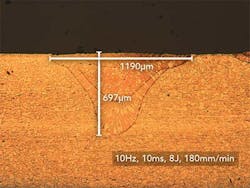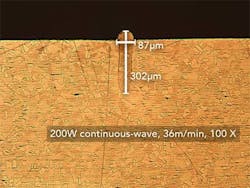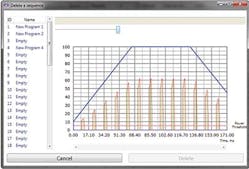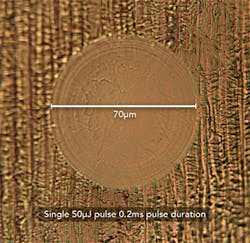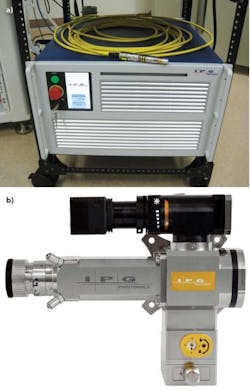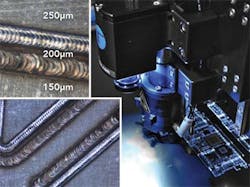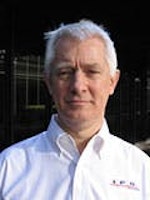Cladding pumped fiber lasers have been a major success in the laser industry in the last decade and recent reports suggest this trend is set to continue. Both low-power fiber lasers for marking and high-power multi-kilowatt fiber lasers for cutting and welding are rapidly growing their market share. Recent reports suggest that the number of multi-kilowatt fiber lasers employed in industry for flat sheet metal cutting will very soon overtake the number of CO2 lasers sold into the largest industrial laser market [1]. In addition, fiber laser components in the form of fiber amplifiers or fiber oscillators are now being widely adopted as key components for building shorter pulse lasers in the picosecond and femtosecond regime.
Quasi-continuous-wave lasers
Here, we report on a third type of fiber laser that is also making rapid progress in capturing market share. A range of infrared (IR) fiber lasers known as quasi-continuous-wave (QCW) lasers are now rapidly displacing the long-established Nd:YAG flashlamp pumped laser technology. The generic benefits of fiber lasers over other laser types—their wall plug efficiency, reliability, zero maintenance, stability, and reduced footprint—are now very well documented, and QCW fiber lasers have all of these same benefits. Since winning the Prism award in 2011, this laser has been developed into a full range of unique lasers, with some models having up to 20kW peak power. Because cutting and drilling applications have been covered in previous articles [2], the broader capabilities of this range of lasers are covered here.
The initial justification for developing these lasers was to bring the benefits of fiber lasers to low-average-power, low-duty-cycle pulsed laser welds such as the conduction-limited spot weld shown in FIGURE 1. It was quickly understood that the high-brightness capability of these sources allowed much smaller feed (delivery) fiber diameters to be employed. Indeed, one laser of this range type can be fitted with a single-mode (<15µm) diameter fiber, enabling impressive precision cutting and drilling performance [2].
Many (but not all) fiber lasers have a special feature that differentiates them from other laser technologies—single-emitter diode laser pump sources. A large part of the success of the leading manufacturer of high-power fiber lasers is due to the robustness and lifetime of these single emitters. Using single emitters as opposed to diode bars or stacks for pumping has another major benefit in that active fibers can be pumped at duty cycles from close to 0–100%, in turn enabling modulation of CW lasers over the same range. It is this same flexibility that is responsible for the QCW fiber laser.
The diameter of the active fiber in a fiber laser is by its nature very small indeed (<15µm), so only a single laser mode is generated. This not only allows very efficient generation of coherent light, but the fiber is almost completely self-cooling due to the uniquely high surface-area-to-volume ratio. Temperature fluctuations and their related thermal effects are therefore absent, leading to unprecedented output beam stability.
The second important result of generating the laser beam in a small diameter active fiber is that if necessary, the laser output can be delivered via a single-mode passive fiber (known as "feed fiber") all the way to the laser machining head. In this case, the beam has the highest possible brightness and focusability. Splicing larger-diameter feed fibers onto the active fiber or simply employing a fiber coupler device is widely used by those skilled in the art when, as in many materials processing applications, a different range of beam diameters and focused spot sizes are required directly from the laser.
What are QCW pulsed fiber lasers?
The widely accepted definition of the prefix "quasi-" is that the subject retains some characteristics of itself. Therefore, a QCW fiber laser retains all of the well-known benefits of continuous-wave (CW) fiber lasers, but there is one key feature that increases peak power by a factor of 10X over CW lasers-increased numbers of pump diodes are simply spliced into the active fiber. Limiting the duty cycle of these diodes to 10% requires a far smaller power supply but, when in this pulsed mode, the laser provides 10X higher instantaneous (peak) power. In some versions, pulse energy as high as 60J is possible in low-millisecond pulses.
The peak power of a laser pulse is strongly related to the ability of a particular laser to "couple in" or break down the reflectivity of a metallic surface to start producing a weld. As true QCW pulsed lasers have an order-of-magnitude higher peak power, this coupling ability is greatly enhanced. This unique feature has now allowed the QCW laser to compete very successfully with older technology flashlamp lasers and with CW fiber lasers in the field of low-power laser welding.
As the initial target application for this laser was spot welding, it is very important to note that a 150W CW laser will need 67ms to produce a modulated pulse of 10J. In this scenario, the peak power of the beam is the same as the CW power: 150W. Equation 1 confirms that in this low-peak-power scenario, a much-lower peak power density (or irradiance) is produced.
The lowest-power QCW laser, however, can typically produce 10J at 15Hz in 8ms at a peak power of 1250W for a conduction-limited spot weld similar to that shown in FIGURE 1. Clearly, greatly reduced collateral heating of the welded component will occur in 10ms as compared to 67ms.
The nomenclature that has been chosen for this range of lasers that reflects the enhanced peak power is as follows: XXX/YYYY, where XXX is the average power and YYYY is the peak power—peak power is always 10 times larger than the average power. So, a 150/1500 laser emits 150W of average power and 1500W peak power in the pulsed regime, with a maximum of 10% duty cycle. This range has now been developed up to 2kW average power, with 20kW peak power for high-speed laser drilling of aerospace alloys (FIGURE 2).In essence, if peak power is required for any particular laser process, then this laser type can provide it in a far more cost-effective package than a CW laser with an equivalent peak power. Newer versions of this QCW laser can include a 10μs minimum pulse duration option. It should also be noted that the maximum pulse duration limit is inversely proportional to peak power: 10ms for 1500W, 15ms for 1000W, 50ms for 300W and lower. So far, longer pulses and higher duty cycles are therefore available if high peak power requirements are low, such as when welding lower reflectivity metals.
QCW in CW or CW modulated mode
Another unique feature enabled by diode pumping with single emitters that justifies the prefix "quasi-" in QCW is that this laser can also be run in either pulsed or CW mode. In CW mode, the QCW laser typically has 30% higher average power throughout the range. QCW fiber lasers in CW mode can be modulated to minimize heat input to the component during cutting in this modulated CW regime. Also in this CW mode, low mode fibers combined with galvanometer scanners allow very high-speed, high-aspect-ratio 'micro keyhole' welds (FIGURE 3), although extremely good fit-up of the components is required in this case when compared to the weld shown in FIGURE 1.Temporal pulse shaping mode
Temporal pulse shaping is a technique that has been used in conjunction with flashlamp-pumped lasers for many years. For certain medical device applications, such as laser welding of titanium cardiac pacemaker cans, this technique has become widely adopted. A specialized pulse shape generator (PSG) graphical user interface (GUI) now allows flexible temporal pulse shaping that can provide a ramp up/ramp down of the pulse energy on QCW lasers (FIGURE 4). This is used to avoid a "weld pipe" or porosity related to weld shrinkage at the start/stop points in laser welds.High-brightness applications
Using a laser machining head (fitted with a 50mm focal length lens and a 60mm focal length collimator in conjunction with a single-mode fiber produces a focused spot <20µm in diameter. As peak power density (irradiance) is related to the area of the focused spot (EQUATION 1), peak power density close to 500MW/cm2 is readily achieved. Never before has this level of peak power density been available from a cost-effective fiber laser that employs off-the-shelf beam delivery systems and has a multi-joule pulse energy capability. This places the processing capabilities of this laser firmly into the regime where nonlinear phenomena can be produced and those materials that are usually highly transmissive to this 1070nm wavelength can be successfully laser-processed. The best known of these applications is laser cutting of various types of glasses, cutting and drilling of sapphire and alumina, and even cutting of silicon [2], although the relatively long beam interaction times may in some cases require post-processing.Welding of aluminum
In this case, the combination of peak power, pulse energy, and average power provided by the 300/3000 (FIGURE 6a), or even the 450/4500 air-cooled versions of the QCW laser, are ideally suited for the well-known microwave package welding application that was previously performed by flashlamp-pumped Nd:YAG lasers. To achieve the correct combination of high pulse energy and spot size, a multimode feed fiber of 100 or even 200µm in diameter is often combined with a 100mm focal length collimator and a longer 200mm focal length lens in a specialized welding head (FIGURE 6b).Battery manufacture
With the current strong interest in energy storage, QCW lasers look set to play their role. Welding of battery tabs at high speed using single laser pulses from a QCW laser is now well established. Dissimilar metal joints between aluminum and steel and even copper and aluminum have now been developed. There are two approaches to achieving sufficient electrical contact from laser welding:
- A spinning beam technique to produce spiral or small-diameter concentric ring welds
- A number of high-pulse-energy, single-pulse laser welds on each tab
Using combinations of dissimilar metals produces welds that might not be recognized as such by welding metallurgists, but clever design of the modules to limit mechanical loads on these joints appears to have solved some of these issues.
Solder mask stencil manufacture
Tannlin [3] is one of the early adopters of fiber laser technology for their range of sophisticated stencil cutting machines. These integrated laser stencil cutting machines incorporate simultaneous automatic optical inspection for the manufacture of high-performance stencils in electronics assembly processing. A new direct laser-welded multilevel process has been developed, allowing greater flexibility and accuracy in the print process over standard SMT stencils traditionally made using photo/electro-chemical and mechanical milling techniques. This allows an increase or decrease of paste volume and deposit height on selected PCB areas, where there is mixed component technology, large ground pads, intrusive reflow, or coplanarity issues. This technology also improves the stencil-to-board gasket and print repeatability, where topography issues on PCBs such as labels, solder mask inconsistencies, and tented vias are present. In addition, simultaneous printing of 3D cavities on PCBs is now possible. To enable this multi-layer approach, highly specialized fiber laser beam delivery equipment was developed to allow cutting and welding with the same laser using the same beam delivery (FIGURE 7). It is abundantly clear that no other laser type has the flexibility and stability to allow this combination of high-quality cutting and micro-welding.Novel laser joining techniques
Although the use of IR fiber lasers for welding of polymers is unexpected, they have found applications for producing small features such as those required in microfluidic devices. In such cases, the feed fiber diameters used are much larger than would be used for processing metals, so the resultant beams have the relatively flat top-hat spatial profile required for polymer welding. The high brightness of fiber lasers allows these small focused spots (small in polymer welding terms) to be produced with long-focal-length lenses. This has the advantage of a long Rayleigh range and hence a process that is very tolerant to variations in component geometry in the vertical dimension. In other cases, collimated parallel beams have been used where Z height and distance from the workpiece becomes irrelevant.
Although this technique still in its infancy, autogeneous bonding of polymers to metals has also been demonstrated [4] using a QCW laser in CW mode with a large-diameter fiber.
Conclusion
The many now well-known positive attributes of fiber lasers—combined with innovative laser design plus the benefit of large scale in house manufacturing—have come together to produce another range of fiber lasers that is making serious inroads into another large segment of the industrial laser market.
REFERENCES
1. D. Belforte, "Fiber laser revenues boost the 2013 laser market," Industrial Laser Solutions, 29, 1, 6–9 (2014).
2. M. Mendes, R. Sarrafi, J. Schoenly, and R. Vangemert, "Fiber laser micromachining in high-volume manufacturing," Industrial Laser Solutions, 30, 3, 23–27 (2015).
3. See www.tannlin.com.
4. S. Katayama and Y. Kawahito, "Laser joining of plastic and metal," Industrial Laser Solutions, 29, 4, 22–23, 30 (2014).
